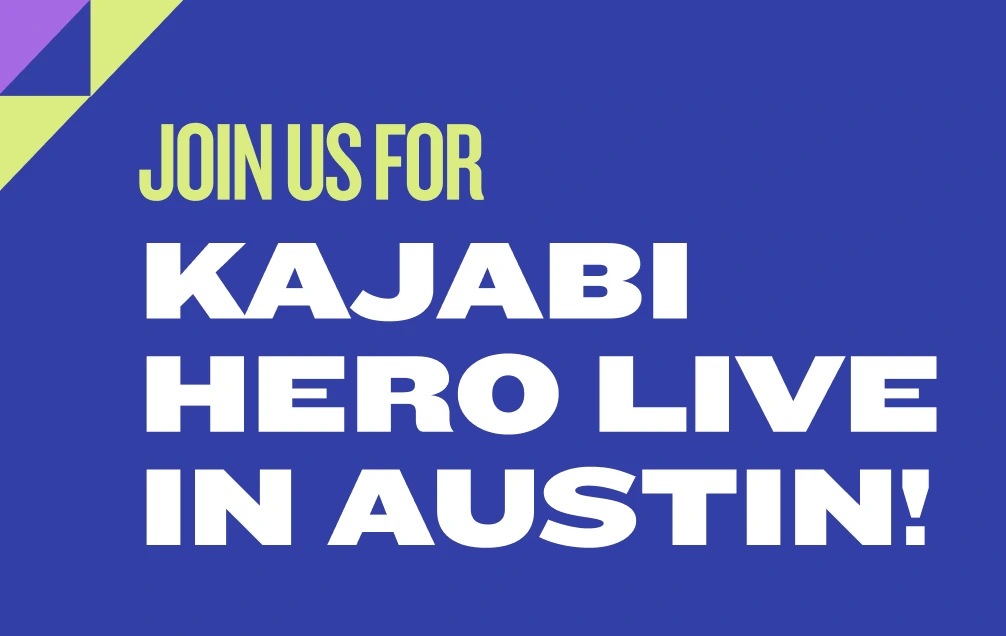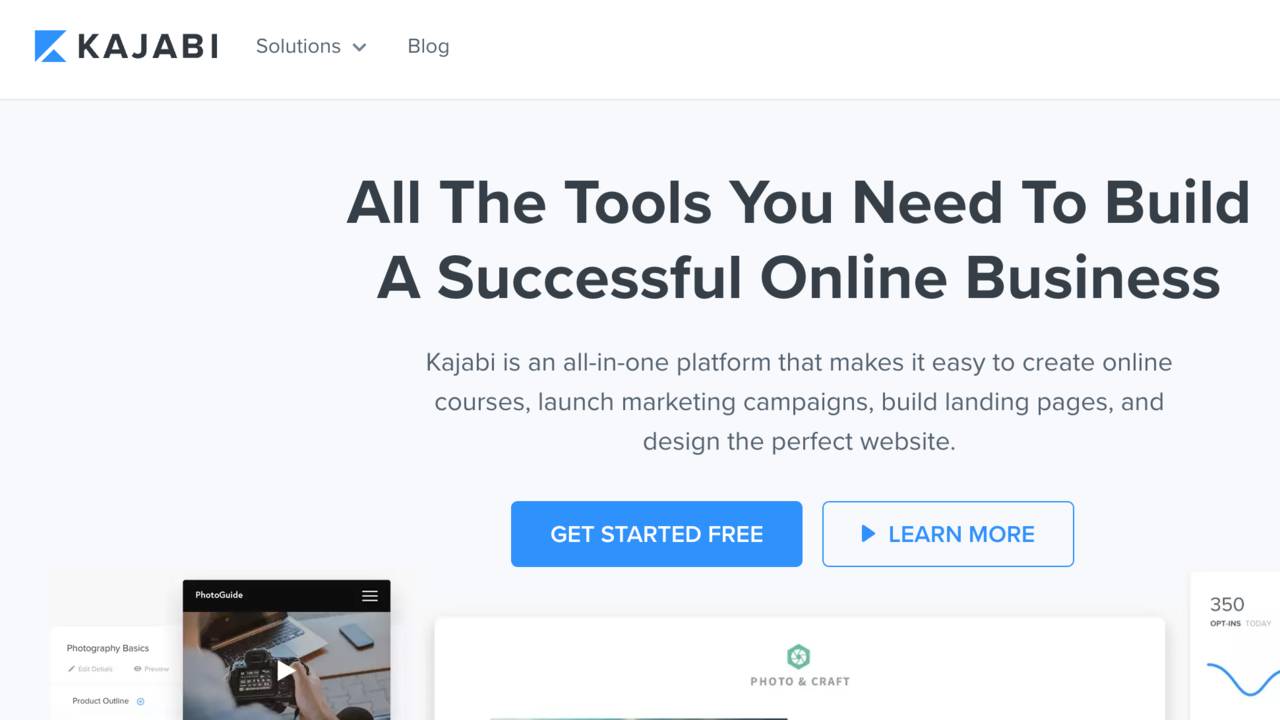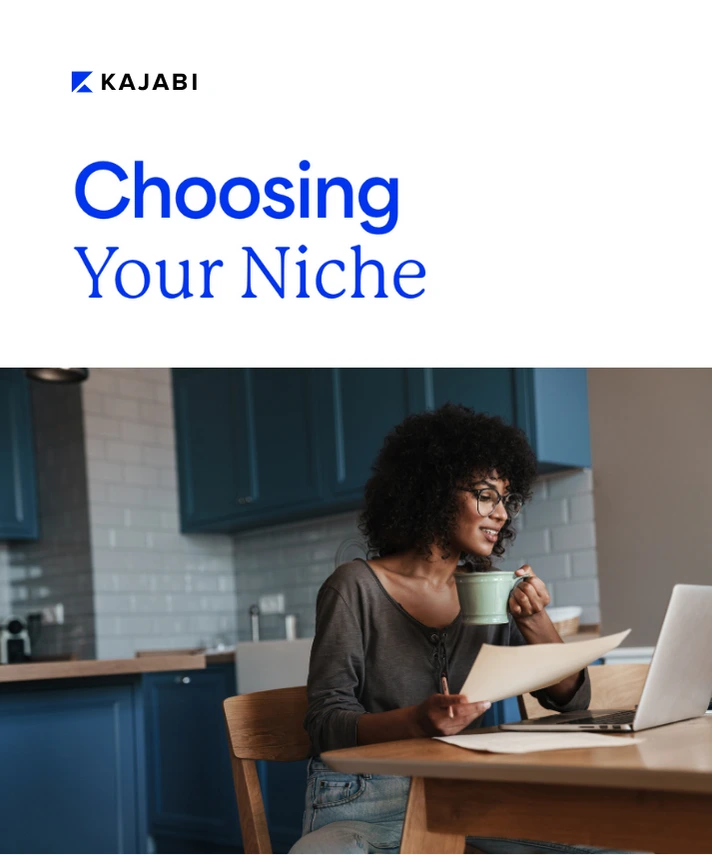
20 Examples of Facebook Messenger Chatbots to Inspire You in 2022
Get free expert insights and tips to grow your knowledge business sent right to your inbox.
We all need a little inspiration from time to time. It’s like when you want to revamp your living room, so you spend six hours scrolling through lifestyle boards on Pinterest.
The same benefits can arise from getting a peek at chatbot examples. Maybe you already know that your Knowledge Commerce business needs a chatbot, but you’re not sure how to implement one successfully.
To help you make the most of your marketing strategies, we’re going to explain why chatbots should matter for your Knowledge Commerce business and help you figure out how to implement one successfully.
Plus, we’ve come up with 20 examples to get your motor running.
Why Should Chatbots Matter to Knowledge Commerce Entrepreneurs?
Your goal with marketing and advertising is always to boost ROI, right? You want your return on investment to exceed your wildest dreams, but to reach that goal, you need the best tools.
Chatbots offer an efficient, easy-to-implement solution that often works better than SMS and email marketing. Plus, it can fit right into your social media strategy.
No matter the digital products you create, you can use chatbots to promote them. Plus, chatbots allow you to form deeper relationships with your customers and to help nurturing existing customers for future purchases.
The problem is that many Knowledge Commerce entrepreneurs assume that chatbots are only for service businesses or retailers. That’s not the case at all.
In fact, as you’ll see below, we’ve selected examples from just about every industry: transportation, health care, retail, finance, and of course, Knowledge Commerce. There’s a wealth of inspiration there.
The point to remember is that you can fit any marketing strategy to suit your own purposes. After we show you the chatbot examples we’ve chosen, we’ll help you mold them to your own business.
Knowledge Commerce entrepreneurs are in the business of selling what they know. Your business allows you to translate your knowledge into cash.
First, before you dive into your mountains of money like Scrooge McDuck, you need customers to find your digital products. That’s where marketing tools like chatbots come in.
They’re also excellent for branding. When prospects get more familiar with your brand, they’ll find themselves more likely to buy your products — instead of those offered by your competitors — because they’re familiar with you and feel comfortable with your public image.
That’s a great thing for any entrepreneur.
Let’s look at how chatbots are serving some of the most innovative companies in the world. Then we’ll talk about how to apply what you’ve learned from them to your own business.
1. Lyft

Lyft uses a chatbot to help its customers schedule rides from one place to another. The bot corresponds with users just as a human does, so customers feel comfortable and engaged.
We’re particularly impressed with Lyft’s chatbot because it incorporates safety. After a customer arranges a ride and the driver gets dispatched, the bot sends a photography of the driver’s license plate as well as a description of the vehicle.
Customers know they won’t have to approach strange cars or risk getting into a car that’s not affiliated with Lyft. This sends the message that the company cares about its customers and wants to keep them safe, which helps elevate the company’s brand message.
You’ll also notice that the Lyft chatbot is fairly simple to use. The company hasn’t added any unnecessary bells and whistles that might confuse or irritate customers.
2. Fandango
Movie fanatics can always download the Fandago app to watch trailers, read reviews of recently released films, and interact with other people who love motion pictures. However, now they can do some of that without ever leaving Facebook.
The Fandango chatbot lets users view trailers for movies they’re excited about seeing. They can also use the chatbot to find local showings for desired movies, which can save a lot of time when you’re making last-minute plans.
Chatbots like Fandango’s prove that you don’t have to center a chatbot around a corporate initiative. This bot is designed for people who simply love movies, and if your customers love something else, you can engage them with a related bot that packs in plenty of value.
3. Spotify
We all love music, right? And many of us use Spotify to listen to old favorites as well as to discover new songs and artists. Last year, Spotify launched a chatbot for Facebook Messenger that includes a social component.
Subscribers can not only learn about newly released music and ask about questions related to their accounts, but they can also choose clips of songs their friends might be interested in hearing.
The Spotify bot will also take into consideration users’ moods, preferences, and previous listening history to make recommendations. Companies that manage to unify all their tools make the experience seamless and encourage customers to remain loyal instead of checking out competitors.
4. Whole Foods
Nobody can accuse Whole Foods of falling behind the innovative eight-ball. The company has enjoyed fantastic success with its branding and its brand positioning. It’s no surprise, then, that the company also has launched an innovative chatbot for Messenger.
With the chatbot, health-conscious consumers can search for fresh, wholesome recipes. Of course, you can do that anywhere, but Whole Foods has raised the stakes. Consumers can now search based on emojis. That’s a great way to reel in the younger demographic and to help people search faster on social.
This type of bot is also adept at keeping customers loyal. You can find out if your local Whole Foods has the necessary ingredients for a recipe in stock, for instance, so you don’t wind up with a bag full of groceries and no ability to make what you’re craving.
5. Mastercard

Who carries cash these days? Transactions are conducted every second in myriad ways, from credit cards stored on mobile devices to online payment transfer services. Mastercard, in a solid move to avoid being left behind, created two chatbots: one for banks and one for merchants.
According to Mastercard’s press release, the bot for merchants is designed to facilitate transactions right in Messenger. Consumers can place orders and create accounts; they can also employ Masterpass to make each transaction easier.
Let’s face it: People crave convenience, but they also want security when it comes to their financial lives. Mastercard has united the two desires in a chatbot that allows customers to communicate privately with the company.
6. Staples
When you hear the word “Watson,” your mind might automatically drift to Sherlock Holmes. Now, however, Staples has employed the name for its signature chatbot, which is a little more sophisticated than the ones we’ve already covered.
Watson — a replacement for the previous Easy Button — allows office and supply managers to order products with ease. It has an artificial intelligence behind it, courtesy of IBM, that translates speech into text, then translates the text into requested products.
Essentially, a user could ask Watson for toner cartridges. The AI behind Watson can then find the specific SKUs, verify an order quantity, and process the transaction.
In this case, we’re covering a chatbot that has a business-oriented end user. The average consumer won’t use Watson to order a few pens for the home office. Staples’s chatbot illustrates why it’s essential to know your target audience.
7. The Wall Street Journal

It’s never been easier to keep your finger firmly pressed to the latest news and developments. The Wall Street Journal, one of the U.S.’s most celebrated publications, has created a Facebook Messenger chatbot that allows users to get breaking news delivered right to their Facebook accounts.
It couldn’t be easier. You can type just about anything in the bot to get what you want, whether it’s top news, market reports, or regional information. Looking for stock reports? Type a company’s name preceded by the word “lookup” (such as “Lookup Apple”) or its ticker symbol after the dollar sign (“$APPL).
Simplicity is one of the key cornerstones of a great chatbot. While lots of bells and whistles might make your bot look impressive, it can also irritate users. If they can’t find what they want or need quickly, they’ll move on to something else.
A good rule of thumb: The chatbot should work faster than a simple Google search.
8. Pizza Hut
It might seem obvious that food service companies would want to jump on the chatbot bandwagon. Pizza Hut certainly seems to think it’s a good idea.
The company has created chatbots for both Facebook and Twitter. Customers can order their food without leaving their chosen social media platform, which makes organizing a pizza-and-movie night easier than ever before.
In addition to placing orders, customers can also ask questions about customer support, payment options, and more. The chatbot experience recreates the experience of talking to a human being, but without the long hold times on the phone.
This illustrates how chatbots are providing variety. People can still visit PizzaHut.com, sign into their accounts, and order pizzas through the virtual system. They can also call their local restaurants to place an order or drop by the store. Chatbots just offer yet another solution.
9. Marriott International

Although it first launched via SMS in 2014, Marriott International’s chatbot now works with Facebook, Slack, and more. Customers can arrange to stay as guests at Marriott hotels and handle other hospitality-related arrangements, such as group conferences.
The company claims an impressive five-second response time and has gradually expanded the chatbot’s AI to offer more complex services via messenger. Guests can also communicate with the chatbot while they’re staying at a Marriott property instead of contacting guest services another way.
If you spend time with the Marriott chatbot, you’ll also notice that the company uses it to upsell their customers. They want guests to get the best suites, spend the money money, and enjoy more time in their hotels. This chatbot example shows how to do so deftly.
10. Woebot
The Washington Post calls it “chatbot therapy.” Woebot, a downloadable chatbot, can act as a robotic therapist for people who need to monitor their moods and check in with themselves on a regular basis. It offers a non-intrusive way for people to keep track of their self-care without visiting a real therapist.
Of course, Woebot doesn’t replace the guidance of a licensed professional. However, it can be a useful and beneficial antecedent to medical or psychological intervention. And for people who don’t need professional help, Woebot might become a therapeutic best friend.
Chatbots are anonymous and don’t come with the stigmas sometimes attached to other mental health outlets. Plus, many people don’t have access to convenient mental health care.
11. Trulia

When you want to buy or rent a house, or if you’re interested in learning about a neighborhood or community, you might turn immediately to Google. Trulia, a real estate company, has introduced a chatbot that gives consumers another avenue for information.
The Trulia bot was primarily built for renters, who often have to jump on properties as soon as they become available. Users can search for “rentals in New York City,” for example, or get more detailed with commands like “three bed two bath for rent in Chicago.” Trulia bot then returns applicable listings.
Many people use chatbots exclusively through mobile. They’re riding the subway to work, waiting in line at the post office, or taking their kids to school. If they can get instant information on which they can act, they’ll be more likely to return to the company that helped in their time of need. That’s often where chatbots excel.
12. HealthTap
Some chatbots, such as the one designed by HealthTap, combine AI with human interaction based on the needs of the user. HealthTap’s bot allows users to ask questions about their medical concerns, symptoms, and histories.
If the chatbot can’t provide sufficient information, the user can direct his or her question to one of more than 100,000 doctors who are on standby to provide answers and reassurance. Those doctors can refer users to physicians or other health care facilities or advice users on how to treat their symptoms on their own.
Keep in mind that the health care industry is fraught with legal obstacles companies must overcome to reach their customers. Chatbots are private and secure, but they don’t replace medical intervention. If you teach courses related to health care, your customers might appreciate a safe space to chat.
13. Spring Bot
Many people dream of hiring their own personal stylists or fashion assistants, but few can afford such a luxury. The Spring Bot helps bridge that gap a bit by providing a bot that acts as a personal shopping assistant. The bot can recommend brands and products after interacting with the user.
This bot, like many others, relies on questions, answers, and clicks. The bot gives the user options, such as “men’s clothing” or “women’s clothing,” then helps narrow down product options based on subsequent questions. For instance, it might ask if you’re looking for “shirts, slacks, blouses, or skirts.” You then tap on the appropriate answer.
Personalization, as this chatbot example illustrates, is an essential part of building a successful bot. You want to deliver the right information to the right customer.
Asking questions and understanding user intent are both important if you want to have success with your own chatbot. Fortunately, services like ManyChat make customization easy.
14. EstherBot

We’ve been talking a lot about big companies, so let’s go smaller for a second. Esther Crawford, a product marketer, created a bot to replace her resume. She realized that she had tired of LinkedIn and other standard options, and chatbots seemed like the ideal solution.
This is a great example of a simple chatbot that serves a very specific purpose. You don’t need an API developer and tons of other professionals on your team. You just need a goal and purpose to get started with chatbots.
It also shows that you don’t have to rely on just one chatbot. Esther Crawford could create a Facebook Messenger chatbot to help her customers understand her services or to guide them through the decision-making process.
15. Surveybot
People create chatbots for lots of reasons. Some are very broad — such as customer service or marketing — while others are more specific. For instance, you can use a bot on Facebook Messenger to survey your audience.
Surveybot makes it pretty simple. You just create the survey, collect answers from people on Facebook Messenger, and analyze the results. The platform even lets you segment your audience, just as you would do for email marketing, for more accurate feedback.
16. Marvel
If you’ve ever wanted to become a superhero, now’s your chance. Marvel, the comics powerhouse, has created a chatbot that’s part conversational tool and part gamification.
You can have a chat with Superman, join forces with Marvel Universe against a common enemy, and get exclusive Marvel content. What comics lover could want more?
Chatbot examples that deal in entertainment might seem frivolous — maybe even irrelevant. However, you’ll notice that Marvel’s chatbot immerses users in the Marvel Universe.
Users feel connected to the company and its characters, and by getting sneak peeks of upcoming products and exclusive bonuses, they’re more likely to buy Marvel products in the future.
17. Skyscanner
Flights can get expensive, but Skyscanner wants to help you find the cheapest, most convenient route from Point A to Point B. Now, instead of searching the website, you can send a private message to the company on Skyscanner and use its bot.
Not only can you find flights from a specific origination to a specific destination, but you can also leave your destination open-ended. Maybe you live in London, England, but you don’t care where you go. You just want to get out of Dodge. Skyscanner can help.
Earlier, we mentioned that many people use chatbots while on the go. They’re tapping on their tablets or smartphones, so they need information quickly and without a lot of fuss.
Since Skyscanner allows relatively simple wording and shorthand, it can deliver results customers appreciate.
18. Flightbot
Along those same lines, Flightbot was designed for pilots (by pilots) instead of for consumers. This is a great example of a B2B-oriented bot that can provide excellent branding and marketing.
Users can get information about delays, FAA rules, and other information. Both drone and regular pilots can find value in the product.
19. TechCrunch
It’s tough to weed through tons of news you don’t really care about to find something that actually interests you. TechCrunch has helped resolve this problem with its chatbot, which delivers personalized news to users.
It’s unique because it uses your search and browser history to help customize recommendations for you. Plus, it works on both Messenger and Telegram, so users have a choice about where they interact with the bot.
20. Sephora

If you want makeup tips designed specifically for you, the Sephora chatbot might be the perfect option. You can get tips, product recommendations, and more delivered to you directly through Facebook Messenger.
The chatbot starts with a quick quiz to better understand your needs. That’s a great lesson for Knowledge Commerce providers, too — if you know your target audience, you can serve up what they want.
The Sephora chatbot is extremely intuitive and easy to use, which makes it a hit with its target audience. Customers can even use the bot when they’re in a Sephora store, bypassing a sales associate and reducing employment costs for the company.
You can see how chatbots might revolutionize entire industries in terms of how they spend money and where they put their most effort.
Chatbots Can Sell Your Online Course, Too
Now that you’ve seen some of these prime examples, maybe you’re already brainstorming ways to incorporate them into your own marketing plan. There are a lot of options out there.
For chatbots to help you sell your online courses, you need a strategy in place. Preferably, you’ll want to use an existing Facebook Messenger chatbot that offers multiple customization tools as well as templates, autoresponders, and drip campaigns.
We recommend ManyChat, but there are lots of other tools out there. Choose one with which you’re comfortable.
After you’ve set up a tool, decide how you’re going to communicate with your subscribers. Correspondents might want to get regular marketing messages, tips related to your industry, discount codes, and more.
They might also want to ask specific questions. You can create a list of pre-prepared answers to the most common questions you hear so you don’t inadvertently waste time.
Then you just need to implement those strategies. Set up an engaging drip campaign, create autoresponders, and set up times each day for checking Facebook Messenger.
If you have a larger team, you might want to assign someone else that responsibility. Delegating can free up time for you to create more courses and other digital products.
Conclusion
It’s easy to see why major companies, such as Whole Foods and Staples, are diving head-first into chatbots. They recognize the incredible value found in this technology.
Unlike many other relatively new marketing strategies, though, chatbots won’t break the bank. They also won’t eat up too much of your time thanks to their “smart” characteristics.
Knowledge Commerce entrepreneurs can use chatbots just like professionals in any other industry. Respond to customer support requests, answer pressing questions, inform subscribers about newly released content, and point prospects toward your hottest digital products.
If you don’t know where to start, take inspiration from companies as varied as Lyft, Mastercard, Pizza Hut, Duolingo, Spring, HealthTap, and Flightbot. You probably won’t copy their strategies exactly, but you can piece together elements from each one you like.
Are you ready to start using chatbots for your Knowledge Commerce business?
Start Building Your Business With Kajabi!
We know that you have something to teach the world. We also know there are people out there who want to learn what you know.
That’s why we created Kajabi. It’s a full-featured platform that allows professionals like you to create their own businesses from home.
Create online courses, establish membership sites, and sell other digital products. We offer tons of marketing tools to help you spread the word about your products and earn more revenue.
Fully explore what Kajabi has to offer and start building your business during a free trial. Start your free 14-day trial of Kajabi today!
Still researching? Check out Kajabi’s free downloadable ebook guides on launching and growing a knowledge commerce online business!
Find more blog posts by category:
Marketing
Kajabi Hero Stories
Create Your Product
Build Your Business
Grow Your Business
Kajabi News













